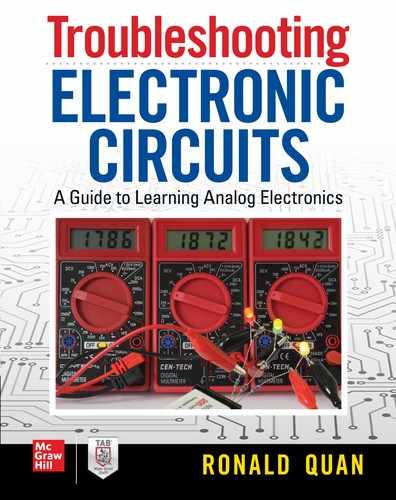![]()
Contents
Quick Notes: Replacing Electrolytic Capacitors and Soldering
Soldering Problems (Cold Solder Connections)
Power Buses on Solderless Breadboards . . . Look for Breaks in the Power Bus Lines
3 Power Sources: Batteries and Battery Holders, Safety Issues, and Voltmeters
4 Some Basic Electronic Components
Radial and Axial Electrolytic Capacitors
Measure Twice, Install Once: Erroneously Marked Capacitors
Using a DVM to Measure Resistance Values
Measuring Low Resistance Values
5 Diodes, Rectifiers, and Zener Diodes
Forward Voltage Across Anode to Cathode and Reverse Voltage Effects
Testing Diodes and Rectifiers with Digital and Analog Volt Meters
Some General Rules About Diodes
LED “Minimum Turn On” Voltages
Problems with Paralleling Two LEDs with Different Turn-On Voltages
Protecting LEDs from Damage Due to Reverse Voltage Across the Anode and Cathode
Some Keys Points About Light Emitting Diodes
7 Bipolar Junction Transistors
What Happens When a Transistor Is Damaged
Schematic Symbol of NPN and PNP Transistors
Applying a DC Voltage to the Base of the Transistor to Provide a Constant Current Source
Improved Current Source Circuits
What Happens When Things Go Wrong
Insufficient “Headroom Voltage” for the Transistor
Sometimes Even a Correct Circuit Goes Bad
8 Troubleshooting Discrete Circuits (Simple Transistor Amplifiers)
Important Practical Transistor Specifications
Simple Transistor Amplifier Circuits
First DC Analysis: Capacitors = Batteries with Self Adjusting Voltages
Second DC Analysis: Take Out the Capacitors to Find the DC Currents and DC Voltages
Output Swing Determined by IC and RL || R2
Troubleshooting the One-Transistor Amplifier
Using Negative Feedback to Build “Mass Production” Amplifiers
DC Analysis of Self-Biasing Amplifier
AC Analysis of a Self-Biased Amplifier
Another Common Emitter Amplifier
Troubleshooting the Amplifier in Figure 8-31
Amplifier’s Emitter AC Grounded via CE
Amplifier’s Emitter Partially AC Grounded via Series RE2 and CE2
Finding an Optimum Bias Point for Maximum Output Swing with Just an Emitter Resistor
9 Analog Integrated Circuits Including Amplifiers and Voltage Regulators
Maximum Safe Power Supply Voltage
Caution on Providing Supply Voltages
A Short Look at Linear Voltage Regulators
Voltage Selections, Packages, Pin Outs and Schematics
Knowing the Pin Out Sequence Is Important
Low–Drop-Out Voltage Regulators
Dynaco PAT-5 Low-Level Preamp Section and Power Supply
Preamp’s DC Bias Point Estimates
A High-Fidelity Audio Power Amplifier
DC Biasing Conditions in Figure 10-9
11 Troubleshooting Analog Integrated Circuits
Circuits That Need Fixing or Redesigning
12 Some Ham Radio Circuits Related to SDR
Software Defined Radio Circuits
Some Troubleshooting Tips Concerning Figure 12-5 and Figure 12-7
A Common Sample-and-Hold RF Mixer Circuit
A Preferred Implementation with Sample-and-Hold Circuits
A Cool Four-Phase Commutating Mixer
Testing Circuit with an RF or Function Generator
Improving the “Original Design”
Another View of Op Amp Circuits (Where the Inverting Input Drives a Load)
Low-Frequency Cylindrical Crystals, “Standard” Crystals, and Ceramic Resonators
Standard HC-49 and High-Frequency Cylindrical Crystals
Gain Bandwidth Product Revisited
13 Timer, CMOS, and Motor Drive Circuits
Basic Modes of the 555 Timer Chip and Pin Outs
The 555 Pulse Generator (a.k.a., One-Shot or Monostable Mode)
Troubleshooting the 555 One-Shot Monostable Timer
When You Want to AC Couple a Signal to Trigger a Pulse Output Signal
“Strange” Output Signals Observed via an Oscilloscope
Troubleshooting the 555 Oscillator (a.k.a. Astable Mode)
One More Example on Driving Speakers with the 555
Why Again an Output Coupling Capacitor Is Preferable
Using a 555 to Drive Motors via Pulse-Width Modulation
Summary of Troubleshooting Techniques
14 Troubleshooting Other Circuits, Including Kits and Projects
Component Kits and Test Equipment
A Quick Detour with the LM386 Audio Power Amplifier IC
Photonics: A Light Transceiver System
Thermal Sensing Circuit via Thermistor (Temperature-Dependent Resistor)
A Circuit Using an Electrolytic Capacitor Incorrectly
Identifying and Fixing “Bad” Circuit Designs
An Example of the Missing Ground Connection
Ferrite Beads to Tame Parasitic Oscillations
15 More Tips and Final Thoughts
Deciphering Schematics with Too Many Connection Flags
Troubleshooting with Minimal Test Equipment
Analog Meter Driving Circuits for AC Signals
Troubleshooting an Older Push Pull Audio Amplifier in a 1950s Transistor Radio
Reducing Noise on the Power Supply Bus with Multiple Circuits
Bad Connections from Some IC Sockets
Lab Power Supplies (Adjustable)
Examples of Display Resolution and Number of Memory Points
C Components and Parts Suppliers
Transistors, FETs, Diodes, LEDs, Photodiodes, and ICs
Low-Noise Transistors and JFETs, Including Matched Pairs
Kit Parts for Transistors, Diodes, Capacitors, Resistors, LEDs, and More
Crystals, Inductors, Capacitors, Transistors, RF Transistors, Transformers, and ICs
Oscillator Coils, IF Transformers, and Audio Transformers
